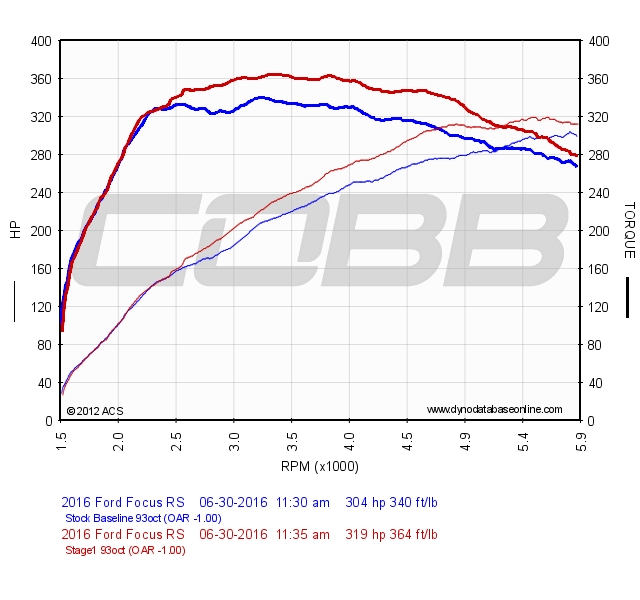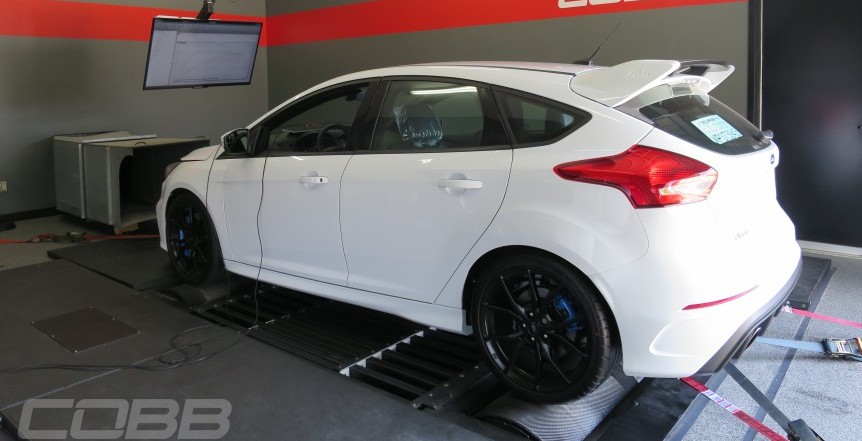Ford Focus RS Power Gains and Development
The Ford Focus RS is now supported! Check out this post for more details!
June 30th – Preliminary Stage 1 Power Gains
Our engineering team learned a lot with their time on the RS in England. After more time on our dyno here at COBB they were able to come up with a safe and reliable Stage1 calibration that still offers some healthy power gains. The below will be similar to the released Stage 1 Off The Shelf map that will come on the Accessport!

When our baseline numbers for the Focus RS were first released, there was a lot of talk about them being inflated and even more concern surrounding the fact we dyno’d the vehicle in FWD instead of AWD mode. There’s good reason for that!
The Focus RS does not have a center differential like other AWD vehicles in its class. Instead, there is an electronically controlled clutch pack that sends a variable amount of power to the rear differential. This system is called the Rear Drive Unit or RDU. When the RDU is active (sending power to the rear wheels), it causes the rear wheels to spin faster than the front. Keep in mind that the dyno rollers are linked front and back so they spin at the same rate. With the rollers spinning at a constant rate, and the vehicle trying to spin the front and rear wheels at different rates, things don’t mesh well. When this is the case, the car actually “thinks” it is losing traction which results in it intentionally limiting power. The best way to dyno the vehicle is in FWD mode with the RDU disconnected. Even if we were able to prevent the car from limiting power in AWD mode, the gains expressed as a percentage will be identical in either FWD or AWD mode. The actual number isn’t too relevant as it will be different with varying dynos and conditions. Check out another post on Interpreting Dyno Results for more details.
The Accessport for the RS platform will be released soon! Stay tuned for more details on the release and information on hard parts and Staged Packages to come!
June 28th – Baseline Dyno Results
It didn’t take long for us to get the RS on the dyno to see some baseline results. Check out the video below for our first look at the Focus RS on the Dyno.
June 22nd – Taking Delivery of the Focus RS
If you keep up with our social media pages you know we’ve been having some fun with Live Video. Last week, we finally got our hands on the new Ford Focus RS here at COBB HQ and Cody took to the interwebs to show off some initial impressions!


So the dyno spins the wheels at the same rate, just like they would on the road, and this causes the car to reduce power to the wheels? That sounds pathetic. If you can’t dyno the car in AWD and have full power, what makes you think you’ll have full power in the real world? Just man up and dyno it in AWD already and see what it actually does. If it doesn’t work properly, that’s on Ford.
I’m sure the car handles great and is a blast to drive, but reading this article has convinced me to never buy a car with this type of AWD system.
Hi Jason,
The wheels do not always spin at the same rate on the road. When the RDU sends 70%, the rear certainly spins faster than the front. The road is a lot different (traction wise) than the car strapped down to a dyno with textured rollers meant for grip.
The engine always makes the same amount of power regardless of how it’s dyno’d. The measured number may be a little different due to differences in drivetrain losses.
Most OEs do not design around their car being used on the dyno. We dyno all vehicles in a manner to get consistent results without harming the drivetrain.
Kyle@COBB
Right, it’s important to remember that at the end of the day the dyno is intended to be a tool to measure changes in power as you go through tuning, etc.
Dyno in drift mode ftw.
Great job guys. Just like the Focus ST, it seems the RS’s intercooler isn’t doing good enough of a job. CAT of 170F/+50 from the start of the pull is pretty crazy for a single dyno pull. I’m sure the tq curve wouldn’t die off as quick with a good FMIC. Hint hint.
@Matt Beaupre, the intercooler actually works too well, that’s why they have a blocking plate in front of it on the right side.